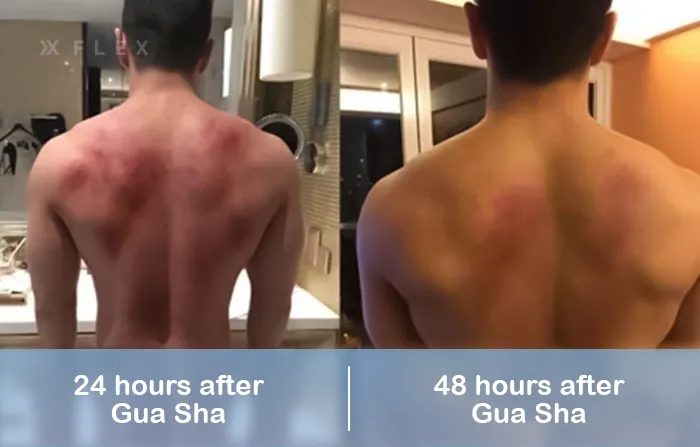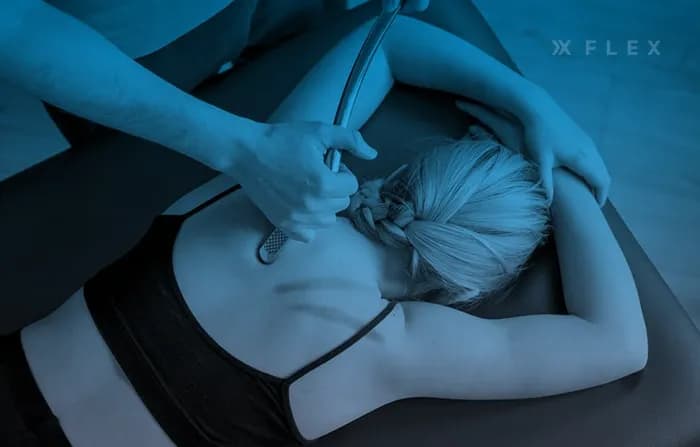What is Muscle Scraping? Techniques and Benefits
What is muscle scraping? This guide will help you learn more about gua sha and other muscle scraping techniques to help your muscles recover.
Learn more about muscle scraping. Is muscle scraping safe and what is its impact on your muscles?
In fitness, we focus a lot on what happens in the gym, boosting muscle endurance with supplements, pre-workout and athletic nutrition and hardcore exercise.
But what you do in your “downtime” can have an impact as well.
Recovery and how you care for your muscles when you’re not working out can have just as big of an impact on how well they perform for you during workouts.
In this article, we’ll unpack the theory behind muscle scraping. What is muscle scraping? Let’s check out how this method with ancient roots can boost your healing time and improve circulation.
What is Muscle Scraping?
Okay, so you may be wondering “What is muscle scraping, anyway?”.
It’s not as intimidating or intrusive as it sounds. The technique doesn’t require surgery.
Muscle scraping is a type of manual therapy that involves using a tool to scrape the muscles from the outside. People also refer to it as instrument-assisted soft tissue mobilization or IASTM.
The goal is to promote muscle healing, and blood circulation, reduce scar tissue, and reduce muscle injuries by stimulating the soft tissue and fascia.
Chiropractors frequently practice muscle scraping in their clinics. It can help break up muscle knots— the sensitive, hard areas on your muscles that pop up from stress to your muscles.
How Does Muscle Scraping Work?
Muscle scraping helps break down restricted soft tissue to help reduce scar tissue or muscle strains. A practitioner will use tools to apply gentle pressure and scrape your muscles to massage the tissue.
Creating micro-tears in the muscle can help direct blood flow to the affected area. The idea is that this can be useful to promote muscle and soft tissue healing.
Ancient gua sha technique would use animal bones or other instruments to scrape the muscles. However many modern practitioners prefer stainless steel tools.
Types of Muscle Scraping
Gua Sha
One of the best-known types of muscle scraping is gua sha. This technique comes from traditional Chinese medicine.
Gua sha is more focused on blood movement under the skin as a healing method than any direct manipulation of muscles.
Practitioners use gua sha to help:
- Myalgia
- Neck pain
- Shoulder pain
- And more
Although some patients report anecdotal benefits of gua sha, there is not enough study on gua sha or other traditional healing techniques to determine whether or not they are beneficial to modern healthcare.

Graston Technique
The Graston Technique is a manual therapy technique. It uses stainless steel tools to move the muscles. It aims to scrape the soft tissue to break apart muscle adhesions. This can help improve muscle function and improve localized pain. This method is used by osteopaths, chiropractors, physiotherapists, and some certified massage therapists or other practitioners.
There are case studies and clinical trials to support the benefits of the Graston technique.
What Are the Benefits of Muscle Scraping?
People often seek out muscle scraping to alleviate pain. That being said, it can come with several noticeable benefits for your body:
Better Circulation
Stimulating your muscles directly can help with blood flow in the soft tissues.
Better circulation helps bring oxygen to the muscles, allowing them to work more efficiently.
Pain Reduction and Improved Range of Motion
Muscle scraping can be a good antidote to chronic pain. For patients experiencing lower back pain, the Graston technique was found to have an impact both on chronic lower back pain and range of motion.
How Can Muscle Scraping Help Your Workout?
If you love to lift weights, there is evidence that muscle scraping could benefit you at the gym.
A controlled trial study found that using gua sha scraping on weightlifters performing snatch and clean and jerk lifts helped them to lift more weight. Those who used gua sha when compared to a control group were able to lift more weight and experienced less perceived effort during their lifts.
And remember, you need to take care of your muscle health outside of the gym too! Focusing on your recovery through techniques like muscle scraping or foam rolling can help you to feel better when you do get in your next workout.
It’s no fun to exercise when you feel too sore. Muscle scraping can help with pain reduction so you’re not struggling through your next big pump day.
Side Effects of Muscle Scraping
Are there any negative effects associated with muscle scraping?
Like with any manual stimulation technique, you may have some visual or physical effects from muscle scraping.
Muscle scraping can cause:
Bruises
You may notice a bruised appearance on your skin after a muscle scraping session. Because the technique applies pressure to the skin directly, it’s normal to come out with a few bruises. Red marks are generally a sign that stagnant tissue and blood are now being broken up to promote healthier blood flow.
Be mindful of purple bruises! Everyone has a unique pain tolerance. However significant purple bruising may mean your practitioner is applying too much tissue to your skin. If you notice purple bruises that hurt, don’t be shy to ask your practitioner to use less pressure.
Gua sha is also used as a facial technique in skincare. In this case, you should never be using hard enough pressure to bruise. Facial skin is more delicate than the rest of the body. Always scale back the pressure if you are using facial gua sha.
That being said, if you have any trauma to the skin, like a cut, and unhealed wound or stitches, skip the muscle scraping until you have healed
Redness
Along with bruises, you may see a red tint that might not be so pleasant to look at. Although you might feel silly, relax. It’s normal!
The redness should begin to disappear soon after your session so you don’t have to feel embarrassed.
Soreness
Do your muscles feel sore after scraping? You may experience some aches or pains after going for a muscle scraping session.
Body check: Although some pain, discomfort or a changed appearance of the skin can come with muscle scraping, it’s important to be gentle with your body.
Check in with how you are feeling if you decide to incorporate muscle scraping or other manual manipulations into your routine. Always make sure to research your practitioner and don’t be afraid to speak up if you are experiencing excessive or abnormal pain.
Is Muscle Scraping Safe?
Although it can come with side effects like bruising or soreness, there is evidence to show that muscle scraping, when administered by a trained and qualified practitioner is a safe practice for most patients.
There is not enough research into any dangers associated with muscle scraping to disqualify it from being considered a safe practice.
That being said, we recommend speaking with a qualified healthcare practitioner if you are experiencing muscle pain, soreness, or circulation issues.
Your practitioner will be able to help you decide if muscle scraping is right for you, or if you may benefit from another form of manual therapy. If you are interested in trying out muscle scraping, make sure to tell your healthcare professional about any history of injuries to the muscle group that you are hoping to scrape.
A professional can help you assess whether this type of therapy can help your muscular health and recovery.
Big Picture
You may look a little red and silly. But muscle scraping can come with many benefits to your muscular health and fitness routine.
These include improved circulation, pain reduction, and better range of motion.
Gua sha and the Graston Technique are the most popular muscle scraping practices. Gua sha originates from traditional Chinese medicine, while the Graston Technique is a Western method that uses stainless steel tools to stimulate the muscles to break up scar tissue in restricted areas.
Blending traditional health practices and modern medicine is still an area of ongoing research.
Although there is scientific evidence to show that these practices can work in harmony, we still need more information and long-term trials on how to integrate traditional healing practices and sports medicine.
That being said, with the consultation of a healthcare professional, there is good evidence to show that you can scrape your muscles to promote healing on the days you take a break from the gym.
Stretch Methods
And remember to incorporate stretch techniques into your workout days to keep those muscles healthy as well. To learn more about stretching, explore techniques like ballistic stretching. Is ballistic stretching safe for healthy muscles?
Off the clock, performing a flexibilty or mobility test can give you clues about the general health of your muscles. It's extra important to work on muscular health in areas like the hip flexors, around the thoracic spine and the psoas. These key areas are some of the most fundamental for keeping your body at optimal function.
For more information, you can read Psoas Exercises.
On your gym days, or your rest days, Flex AI offers an all-in-one workout platform to help you learn new exercises, visualize your fitness journey, and keep all your PRs in one place.
We’ve made it simple to work on customized fitness plans or to introduce a little friendly competition to your fitness community by sharing exercises with your friends. Get started for free through the Flex fitness app.
Related articles


Get fit with Flex
Build muscle & lose weight fast for free.
Available on iPhone + Apple Watch





